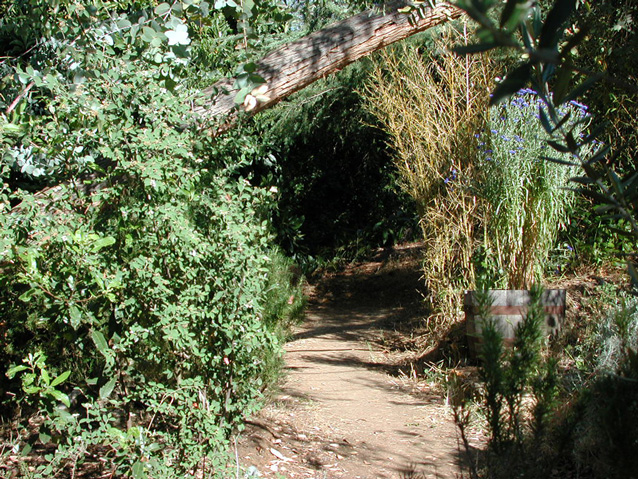[ Sitting Practice ]
The Place to Pace

Its not the place you place
The Place to Pace
That makes The Place to Pace
The best place to pace,
Its the pace you pace
The Place to Pace
That makes The Place to Pace
The best place
To out-pace all the rest
The Place to Pace[1]
Pañc'ime bhikkhave caṅkame ānisaɱsā.||
Katame pañca?||
Addhānakkhamo hoti,||
padhānakkhamo hoti,||
appābādho hoti,||
asitapītakhāyitasāyitasammāpariṇāmaṃ gacchati,||
caṅkamādhigato samādhi ciraṭṭhitiko hoti.||
Ime kho bhikkhave pañca caṅkame ānisaṃsā ti.|| ||
Vocabulary
Pañca: (Latin: quiinque, Gothic. fimf, Lith. penki, (P > F) (English Pinky, finicky, he picks over his food, finger) Old Irish: coic) Five. Hold up your han. Ciñco. Cinq. Cinque. Funf.
PED: "Five" is the number of "comprehensive and yet simple" unity or a set; it is applied in all cases of a natural and handy comprehension of several items into a group, after the five fingers of the hand, which later lies at the bottom of all primitive expressions of No. five ...
The word for 'five' itself in its original form is identical with the word for hand.
Caṅkama: The Place to Pace
Hare: Alley-walk; Warren: Walking Place
Ānisamggsa: (ā: to + ni: down + saṅsa: associated with) praise, i.e. that which is commendable, profit, merit, advantage, good result, blessing in or from.
The Five Advantages to the Virtuous:
1. Great Wealth
2. Good Reputation
3. Self Confidence
4. Meeting Death Unafraid
5. Finding consciousness after death relocated to a happy condition
Addhāna-k-khamo: addhāna: path, road, journey, time + khama: patient, forgiving
2. enduring, bearing, hardened to, fit for.
Hare: harden for travel
Padhāna-k-khamo: padhāna: exertion, energetic, effort, striving, concentration of mind.
The Four:
1. saṅvara: self control
2. pahāna: letting go
3. bhavana: self improvement
4. anura-k-khanṇa: guard
Hare: good for striving
Appābādho: Appa: little bādho: 2 guesses? bādhati: to press, weigh on; oppress, hinder, afflict, harm. bādhana
2. afffliction, injury, hurting
PED: In Pāḷi there seems to have taken place a confusion of roots bādh (oppress) and bandh (tie up > bandhana, brand).
Hare: healthy
Asi-tapīta-khāyita-sāyita-sammā-pari-ṇāmaṃ gacchati:
Asi tapīta: torment, punishment, penance
Khāyita: waste, destruction, consumption decay, ruin, loss
Sāyita: tasting >savour
Sammā pariṇāma gacchati: "bending around" change, alteration
2, alteration of food, digestion, in phrase sammā-pariṇāmang gacchati
Hare: tends to good digestion after one has eaten and drunk, munched and crunched.
Caṅkamādhigato samādhi ciraṭṭhitiko: cira: long (of time) [Latin: while English: wiloon; High Old German: hveila; Gothic: civis; quiees,] ṭ-ṭhitika: standing thusly, perpetual, lasting long.
Hare: the concentration won from (the thought of) an alley-walk lasts long.
MO: Serenity got pacing is long-lasting.
Hare footnotes this: At [an07.58] the Buddha exhorts Moggallāna to concentrate on his alley-walk to get rid of torpor. Comy. here observes: 'By fixing the attentionon the alley-walk, a concentration of the eight attainments (A. iv, 410, omitting the last[2]) is won.
This is the passage from the Hare translation "If it pass not (the drowsiness), then, with the senses withdrawn, the mind not outward gone, shouldst thou fix thy thought on the alley-walk, conscious of its front and back; and maybe, as thou abidest so, that drowsiness will pass."
It is unclear to me as to whether this indicates an instruction as to how to actually use the alley walk, or to simply put one's mind on it (this is in the context, as noted, of instructing Moggallāna in techniques for remaining wakeful). My inclination is towards the idea that this instruction to Moggallāna is a mental exercise, not a technique for use of the place to pace.
In my experience, while using the place to pace, one does not focus the attention on it; one is aware of it (and it certainly becomes associated with good states in the mind), but one uses pacing back and forth as a platform for developing serenity. The pacing back and forth is sufficiently routine that it allows for clear focus on one's subject of meditation (or the other way around, it requires little attention to keep on pacing ... remember the satipaṭṭhana: This is the way he retains just sufficient consciousness to know: "This is the body".) On the other hand given the same skill at attaining a serene state, it is more difficult to do so pacing back and forth than it is sitting and consequently has the benefits of that which is harder-won. My take.
The Place to Pace
[AN 5.29]
Five, Beggars, are the advantages associated with using the place to pace:
1. One stretches and conditions the limbs,,
2. It rouses energy,
3. It is of little harm,
3. One is not afflicted by heartburn and indigestion after eating,
4. The samadhi gained walking the Place to Pace lasts a long time.
My later, more literal (ok, more in conformity with the Pāḷi) translation:
Five, Beggars, are the advantages associated with using the place to pace:
What five?
Lengthened life.
Enduring energy.
Little illness.
Getting optimum digestion of what is eaten, drunk, consumed, tasted.
Serenity got pacing is long-lasting.
The Five Defects of the Walking Place[3]
Hardness and unevenness,
trees in the midst,
dense underbrush,
excessive narrowness,
excessive width.
Note that my place-to-pace has the first four of these.
[1] Footnote to PTS: Cankama (pron. chankāmā) Later, it became a cloister or terraced walk; see Vin.ii, 190 (Vin Texts, iii, 103f.); but originally it must have been merely a clearing in the land about a monk's dwelling; see Comy. at J. i, 7, which gives the five defects (Buddhism in Translations, see below, note, Warren, p21; cf. Rh. Davids, Bud. Birth-stories, p. 89.)
[2]The Four Burnings (jhāna) and the Four Immaterial Burnings.
[3]Warren, Buddhism in Translations, pp9n1
References:
[an05.29] Anguttara Nikāya, 5 #29
PTS: AN 5.29 The Book of the Gradual Sayings or More-Numbered Suttas, III: The Book of the Fives, The Fivefold, ix (#29), The alley-walk, E.M. Hare, trans, pp21
Warren, Buddhism in Translations
AN 7.58: Nodding Off
